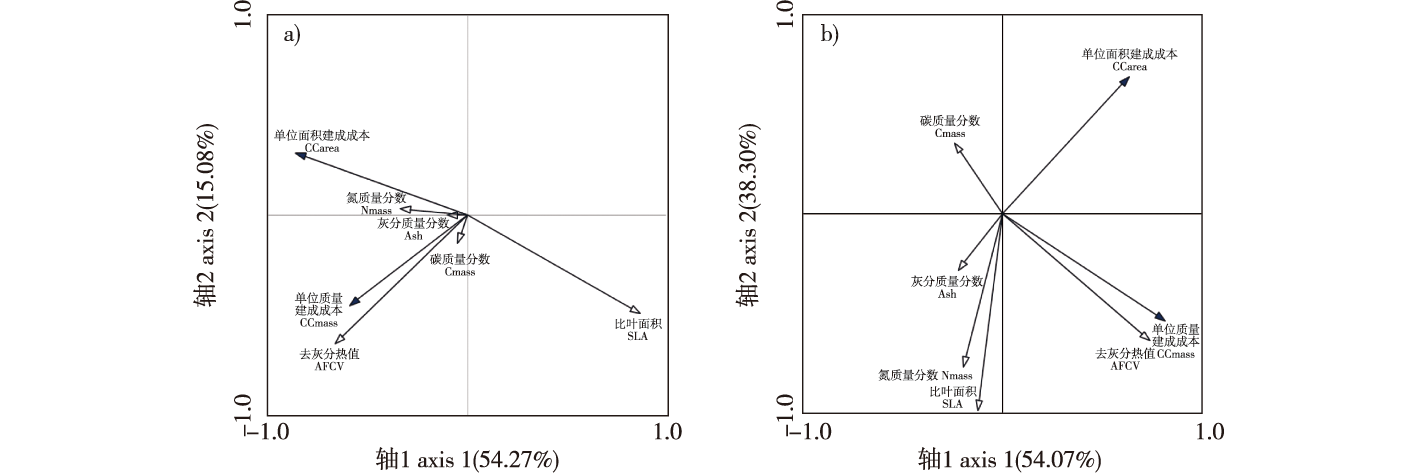 PDF(2080 KB)
PDF(2080 KB)


Variations in the leaf construction cost of Phyllostachys edulis and other dominant tree species during understory vegetation succession
DONG Yawen, CHEN Shuanglin, XIE Yanyan, GUO Ziwu, ZHANG Jingrun, WANG Sheping, XU Yonggan
Journal of Nanjing Forestry University (Natural Sciences Edition) ›› 2025, Vol. 49 ›› Issue (1) : 179-186.
 PDF(2080 KB)
PDF(2080 KB)
 PDF(2080 KB)
PDF(2080 KB)
Variations in the leaf construction cost of Phyllostachys edulis and other dominant tree species during understory vegetation succession
【Objective】 The area of bamboo forests dominated by Phyllostachys edulis in the primary production region is expanding continually due to inadequate management strategies or abandonment, which poses as a serious challenge to the sustainable development of China’s regional bamboo industry and environmental conservation. Negligence or abandonment leads to a positive succession of vegetation in the understory of bamboo forests; however, the adaptive mechanisms and variations in the leaf construction costs of P. edulis and dominant tree species remain unclear.【Method】This study investigated bamboo forests undergoing vegetation succession in the understory at 0, nine and 21 years following neglect or abandonment using One-way ANOVA, Duncan analysis of variance, and redundancy analysis (RDA). The one-and two-degree bamboo plants and dominant tree species, including Schima superba, Lithocarpus harlandii, and Castanopsis sclerophylla, were studied herein. The leaf functional traits, element contents, and calorific values were analyzed, and the association between significant differences in leaf construction costs and the functional traits of Moso bamboo and dominant tree species was determined to explore the energy utilization and growth adaptation strategies of bamboo and dominant tree species. 【Result】The progression of vegetation succession in the understory altered the leaf functional traits of Moso bamboo and dominant tree species, indicating inter-species differences among the dominant tree species and age-related variations in Moso bamboo. The dominant tree species of different diameter classes were mainly S. superba and L. harlandii, with changed in specific leaf area (SLA), while bamboo mainly showed changes in nitrogen content (Nmass), The SLA of S. superba and L. harlandii decreased significantly, while the Nmass of bamboo plants in the 9-year successional bamboo forest was significantly lower than that of bamboo plants in the 21-year successional forest and pure bamboo forest. Understory vegetation succession significantly affected the leaf carbon concentration per unit area (CCarea) of the dominant tree species across different diameter classes, which was especially evident in the increased foliar CCarea of the large and medium diameter S. superba and L. harlandii trees; however, a reverse trend was observed for the medium and small diameter C. sclerophylla trees. The foliar CCarea of the one-degree bamboo plants in the nine-year successional bamboo forests was significantly higher than that in the 21-year successional bamboo forest the pure bamboo forest. Overall, the leaf carbon concentration per unit mass (CCmass) of bamboo and the dominant tree species did not differ significantly. The results of RDA indicated that SLA is a primary indicator that influenced leaf construction costs in dominant tree species, while both the SLA and ash free caloric value (AFCV) were the major indicators that influenced leaf construction costs in bamboo. The correlation analysis revealed that the SLA and CCarea were significantly negatively correlated in both bamboo and the dominant tree species, while AFCV and CCarea were significantly positively correlated in the dominant tree species, but incorrelate to bamboo. Altogether, the findings revealed that dominant tree species and bamboo adapt to changes in resource acquisition and investment strategies during understory succession by adjusting the leaf functional traits, construction costs, and their interrelationships. 【Conclusion】The succession of understory vegetation gradually shifts the roles of dominant tree species and Moso bamboo in forest stands. Dominant tree species and Moso bamboo can adapt to habitat changes caused by the succession of understory vegetation by adjusting the leaf functional traits, construction costs, and their relationships to modify resource acquisition and investment strategies. This study advances the understanding of the dynamics of bamboo forest ecosystems, and provides a scientific basis for the development of effective management and conservation strategies.

Phyllostachys edulis / dominant tree species / understory vegetation succession / leaf construction cost / resource investment strategy
| [1] |
汪亚芳, 刘宗悦, 张宝刚, 等. 入侵毛竹皆伐对亚热带森林土壤微生物生物量和酶活性的影响[J]. 应用生态学报, 2022, 33(5):1233-1239.
|
| [2] |
殷家扬. 弃营年限对毛竹林生态系统林分结构因子和各碳库碳分配格局的影响[D]. 杭州: 浙江农林大学, 2020.
|
| [3] |
|
| [4] |
董周焱, 柏新富, 侯玉平, 等. 胶东滨海8种树木叶片热值、建成成本及其适应能力[J]. 林业科学, 2015, 51(3):8-15.
|
| [5] |
宋莉英, 彭长连, 彭少麟. 华南地区3种入侵植物与本地植物叶片建成成本的比较[J]. 生物多样性, 2009, 17(4):378-384.
|
| [6] |
|
| [7] |
|
| [8] |
朱志敏, 李艳, 吕金枝, 等. 翅果油树及其群落中7种优势木本种类的叶性特征比较[J]. 植物资源与环境学报, 2017, 26(1):107-109.
|
| [9] |
韦伊, 刘慧, 贺鹏程, 等. 南亚热带不同演替阶段森林优势树种叶片构建成本与机械抗性的协同关系[J]. 热带亚热带植物学报, 2022, 30(4):483-491.
|
| [10] |
|
| [11] |
|
| [12] |
陈新微, 李慧燕, 刘红梅, 等. 入侵种银胶菊和三叶鬼针草与本地种气体交换特性的比较[J]. 生态学报, 2016, 36(18):5732-5740.
|
| [13] |
王睿芳, 冯玉龙. 叶物候、构建消耗和偿还时间对入侵植物碳积累的影响[J]. 生态学报, 2009, 29(5):2568-2577.
|
| [14] |
|
| [15] |
陈莹婷, 许振柱. 植物叶经济谱的研究进展[J]. 植物生态学报, 2014, 38(10):1135-1153.
|
| [16] |
孙浩哲, 王襄平, 张树斌, 等. 阔叶红松林不同演替阶段凋落物产量及其稳定性的影响因素[J]. 植物生态学报, 2021, 45(6):594-605.
|
| [17] |
|
| [18] |
|
| [19] |
吴陶红, 龙翠玲, 熊玲, 等. 喀斯特森林不同生长型植物叶片功能性状变异及其适应特征[J]. 应用与环境生物学报, 2023, 29(5):1043-1049.
|
| [20] |
|
| [21] |
胡耀升, 么旭阳, 刘艳红. 长白山森林不同演替阶段比叶面积及其影响因子[J]. 生态学报, 2015, 35(5):1480-1487.
|
| [22] |
莫惟轶, 王瑞丽, 高慧蓉, 等. 黄土高原不同植被带内草地植物叶片解剖性状的变异规律[J]. 生态学报, 2023, 43(3):1135-1146.
|
| [23] |
黄双杰, 曹梦珍, 陈凌芝, 等. 氮素胁迫条件下茶树根系发育及生长素的响应[J]. 江苏农业学报, 2023, 39(3):814-821.
|
| [24] |
于均屹, 徐立清, 张勇, 等. 光照和地下竞争对林冠下人工更新紫椴苗木形态和生物量分配的影响[J]. 森林工程, 2023, 39 (4): 38-47.
|
| [25] |
王常顺, 汪诗平. 植物叶片性状对气候变化的响应研究进展[J]. 植物生态学报, 2015, 39(2):206-216.
|
| [26] |
魏海霞, 霍艳玲, 周忠科, 等. 唐古特白刺叶功能性状沿气候梯度的变异特征[J]. 生态学报, 2022, 42(20):8343-8351.
|
| [27] |
宋长江, 孙旭东, 蔺雪莹, 等. 基于随机森林的帽儿山珍贵硬阔叶树种适宜性分布[J]. 森林工程, 2023, 39 (3): 64-72.
|
| [28] |
|
| [29] |
张晓龙, 吴梦迪, 吴秋堂, 等. 克隆植物对异质生境的适应对策研究进展[J]. 生态学报, 2022, 42(10):4255-4266.
|
| [30] |
葛俊, 邢福. 克隆植物对种间竞争的适应策略[J]. 植物生态学报, 2012, 36(6):587-596.
|
/
| 〈 |
|
〉 |